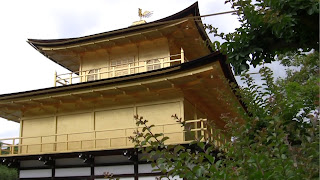Kinkaku-ji which means Temple of the Golden Pavilion is a Zen Buddhist temple located at the foot of the gently-sloping Kinugasa Hill, northern Kyoto, Japan. The Temple’s top two floors are completely covered in gold leaf. The image of the temple richly adorned in gold leaf reflects beautifully in the water of Kyokochi, the mirror pond.
The Pavilion, that constitutes of Kinkaku-ji,
gardens and other buildings, is said to be designed to realize Buddhist
paradise on the earth. The Pavilion's first purpose was to serve the retiring
Shogun Ashikaga Yoshimitsu as a residence. Yoshimitsu was a one of the most powerful
persons during the Muromachi period of Japan. He created a solid political foundation
of Muromachi shogunate and restored the relation between Japan and China. The
Pavilion was turned into a Zen temple after Yoshimitsu’s death in 1408, and
continues to function as a temple of sacred relics.
The first floor of the Pavilion is in the
Japanese palace style and was used for Noh plays or Japanese classical dance
drama. The second floor is in the samurai style and was used for composing
poetry. This floor is built in the Bukke style used in samurai residences.
Inside is a seated Kannon Bodhisattva, as the goddess of mercy Kannon helps
people who are in distress. The third floor is in the old Chinese style and was
used for meditation.
The roof is in a thatched pyramid with
shingles. The building is topped with a bronze phoenix ornament. In Japanese
mythology the Phoenix brings goodwill as it descends from the heavens and is
typically shown sitting on top of a gateway to a Shinto shrine. This ornament adorns
the roof of the Kinkaku-ji Temple, it is a symbol of an imperial household.
From the outside, viewers can see gold
plating added to the upper stories of the Pavilion. The gold leaf covering the
upper stories hints at what is housed inside: the shrines. The outside is a
reflection of the inside. The elements of nature, death, religion, are formed
together to create this connection between the Pavilion and outside intrusions.
The garden complex is an excellent example of
Muromachi period garden design. The Muromachi period is considered to be a
classical age of Japanese garden design. The correlation between buildings and
its settings were greatly emphasized during this period. It was a way to
integrate the structure within the landscape in an artistic way. The garden
designs were characterized by a reduction in scale, a more central purpose, and
a distinct setting. A minimalistic approach was brought to the garden design,
by recreating larger landscapes in a smaller scale around a structure.
Source:
Wikipedia




thanks for the info,
ReplyDeleteglad to read the history of japan, one of the country in asia that never been colonialized